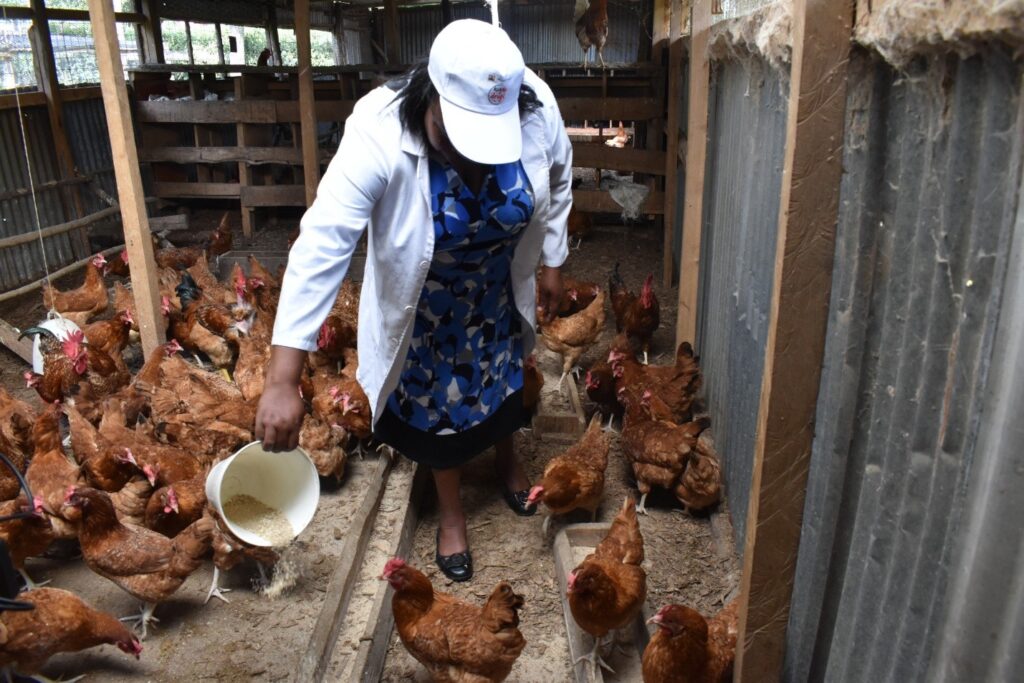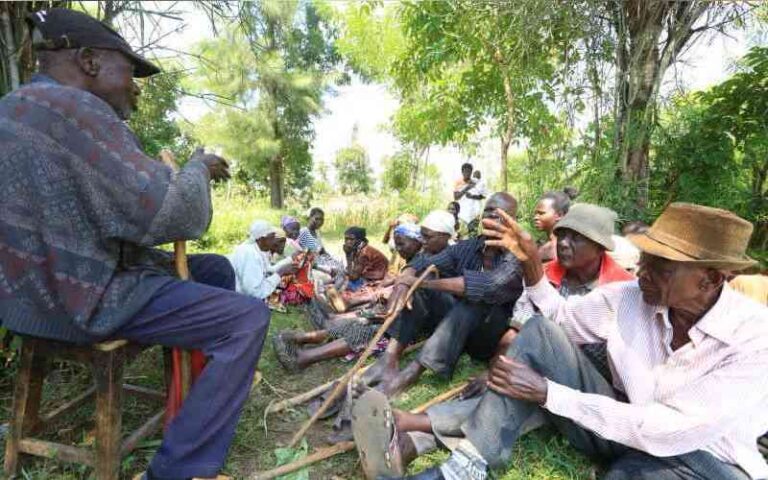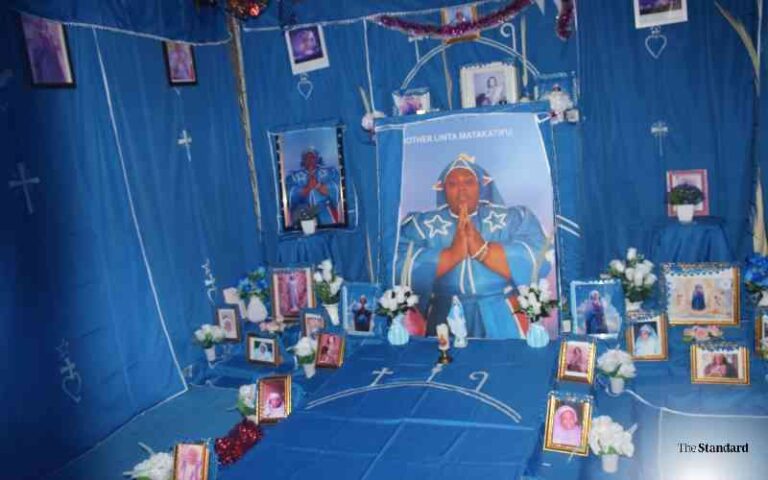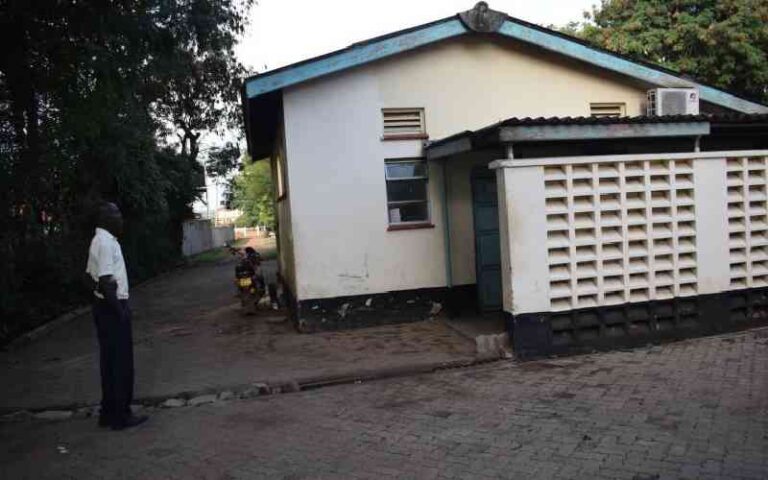Chicken farmers asked to go commercial – Kenya Agricultural and Livestock Research Organization
Small-scale chicken farmers should aim to go commercial. This is one of the foremost messages that the Kenya Agricultural and Livestock Research Organization (KALRO) is promoting.
The organization has developed numerous technologies, innovations, and management practices (TIMPs). These are geared towards improving farmers’ production and boosting their market access so that they can capitalize on the chicken enterprise’s profits.
The chicken value chain has attracted numerous traders of chicken products across the country. One of the most successful is Winnie Cheruiyot. She lives in Tumbelion village in Kaplong, Bomet County. Even though she’s a special needs teacher at St. Kizito School for the Deaf in Litein where she teaches sign language and other subjects, she yielded to her passion and longing for chicken farming.
In 2015, she started with 300 Kalro chicks. She raised them to the laying stage. A Naivasha-based research assistant at the Dairy Research Institute (DRI), Ochieng’ Ouko, recalls how Kalro identified Cheruiyot in February 2021. “We went to look for strategic multipliers to help Kalro to distribute to different parts of the country the chicken we have developed over the years,” he says.
The scrutiny covered several counties: Kakamega, Bomet, Laikipia, Uasin Gishu, and Meru. “I was chosen,” Cheruiyot says. “I was trained and thereafter started working with Kalro.”
Ouko explains that the Kalro training entails the management of standard practices in handling chicken brooding, feeding, vaccination against common diseases and record keeping. The ideal housing for chickens is also covered. “I built the house. Upon inspection by Kalro, it met the recommended standard,” Cheruiyot recalls.
Kalro livestock experts have touted the Kalro Chicken (KC1, 2, and 3) as having attributes that make it suitable for subsistence and commercial farming. The chicken has a speedy growth rate.
The coordinator of the non-ruminant research program at Kalro, Dr Peter Alaru, says, “The breed starts laying eggs at just four-and-a-half months, unlike the pure indigenous kind that takes eight months. The males often attain a weight of two kilograms within four months.”
Kalro gave Cheruiyot the first batch of 500 KC1 one-day-old chicks through the Kenya Climate Smart Agricultural Project (KCSAP). These chicks were obtained from the large-scale Kalro hatchery in Naivasha. She lost very few due to adherence to good agricultural practices (GAPs).
Ouko explains, “Many farmers experience high mortalities because of lack of proper breeding techniques.” He adds, “With the business model that Cheruiyot adopted, we’ve reduced chick mortality from 50 percent to only five percent.”
Kalro has worked with smallholder farmers in Silibwet, Longisa, and Kongasis, among others where chicken mortality was as high as 50 percent due to improper management practices. This intervention is credited with the reduction of mortality to five percent.
“We’ve had increased egg and meat production among the smallholder farmers whom we’ve worked with,” Ouko says. 300 of the 500 birds that Cheruiyot started with turned out to be hens. They began laying. She sold the eggs to different farmers. “I didn’t have a problem with the market,” she says.

Chicken farmer Winnie Cheruiyot. Photo by William Inganga
Buoyed by success with the initial batch, Cheruiyot reached out for 600. “I got motivated because of the ready market,” she says. “The demand was very high.”
She’s noticed that many of her clients prefer the KC1 because of its colour. It’s aesthetically appealing. This improved indigenous breed is black and white spotted. It’s also known as speckled or mottled.
Cheruiyot began brooding chicks for Kalro as a multiplier brooder. “The first batch of one-day-old chicks was 4,000,” she says. “It was very successful. The second batch was another 4,000 chicks.”
She comprehensively understands brooding so much that she describes it as being at her fingertips. She cites patience as a requirement.
A Kalro veterinary doctor, Wilfred Mutisya, says that chickens have many diseases that the farmer needs to worry about. “There are viral, bacterial, and fungal. Others are nutrition deficiency-based,” he says.
The main diseases that affect chickens are Newcastle, Marex, Gumboro, infectious bronchitis, and salmonella, among others. One-day-old chicks from Kalro are pre-vaccinated against Marex, Newcastle, and Gumboro diseases.
Footbaths are at the entrance of the chicken houses on Cheruiyot’s farm. These biosecurity measures ensure that footwear is disinfected before entering the houses.
“Poultry business is lucrative,” Cheruiyot is convinced. “If you invest in it and do it right, you’ll get some returns.”
The chicken enterprise in Kenya contributes four percent of the agricultural GDP,” says Dr Alaru. “The sector supports about 3.6 million households.”
The scientist estimates that the chicken population in the country is 63 million against a world population of about 35 billion.
Cheruiyot’s revenue stream got a boost from selling one-month-old chicks. “At that time, they hadn’t consumed much,” she says. More customers were on the lookout for her eggs. She doesn’t sell a fertilized egg at the same price as the table one. “The table egg can go for Ksh. 15 whereas the fertilized one, at Ksh. 30.”
In the business of selling fertilized eggs, Cheruiyot says, the Kalro recommended ratio of cocks to hens needs to be adhered to. This is contingent on the space available. “If all the eggs are fertilized, you will not miss the market,” she says.
Chicken meat is marketable. “When I have extra cocks, I sell them and get some money,” Cheruiyot says. “I usually dispose of the layers for meat at 60 weeks.”
Cheruiyot is an agent for other chicken firms operating in Bomet, Kericho and Narok Counties. These are Silverlands, Kenchick, Kukuchick and Sasso. She’s a chicken multiplier for these other enterprises.
To hatch her eggs, Cheruiyot has acquired a 528-egg capacity incubator. She’s determined to stick to the vaccination regime espoused by Kalro’s schedule.
“We normally give a booster of Newcastle at day 10,” Dr Mutisya says. “At day 14, a booster for Gumboro is administered. It’s followed by fowl pox vaccine at six weeks, full typhoid at the beginning of eight weeks and infectious coryza at the end of eight weeks.” Another booster of Newcastle is essential at 18 weeks to ensure the birds attain full immunity.
The first brooding she did for KCSAP consisted of 1,000 chicks. She sold all of them. “I earned Sh350,000,” she says. “That was a lot. I had never handled such an amount without going for a loan.”

Dr Wilfred Mutisya, a Kalro veterinary doctor
The earnings motivated her. It dawned on her that poultry pays. She promptly got another consignment under the same project. Her market was in Bomet and Kericho counties. Her earnings enabled her to purchase a car.
Later, “I started brooding more than 10,000 chicks,” she says. “In time, I purchased my trailer worth Sh12 million. It’s leased to Kenya Breweries Ltd.”
In one of her brooding rooms, she cares for 600 chicks. Half may be booked. Feeders and drinkers are neatly placed. Improvised perforated pots with burning charcoal provide and regulate the desired temperatures within the structure.
“During the first day, the house should be 32 degrees centigrade,” Cheruiyot says. She sets up four pots with the burning charcoal embers. She knows when to reduce the pots to two since lower temperatures are required for older chicks. “From day two to six, it should be 30 degrees and in two weeks, 26 degrees,” she says. “At three weeks the ideal temperature is 24.”
One of her challenges is being on the lookout for coccidiosis which is a protozoal disease. It causes diarrhoea, weight loss and decreased production in poultry.
To control this disease, she uses anticoccidial compounds. Vaccination is also key. When clinical signs appear, she uses a combination of antibiotics and multivitamins.
Villages are rife with complaints that there’s no market for eggs. Cheruiyot doesn’t think so. She believes such people think of the market before having the product.

Leonard Mutai from Sotik buys some eggs from Winnie Cheruiyot. Photo by William Inganga
“Searching for the market is easier when you have the product,” she says. She’s met other potential farmers who hesitate to venture into the chicken value chain ostensibly because it’s the preserve of the financially endowed. She advises farmers to think about starting small and consistently growing progressively.
“Poultry business is the easiest to start because you can begin with the smallest number you have. It could be 10 or 20 chickens,” she says.
Dr Alaru says, “Each Kalro hen lays 200-300 eggs yearly.” This is about one egg every two or one and a half days. Each egg weighs 50-60 grams. “The pure indigenous hen lays 80-100 eggs,” Dr Alaru says.
The Kalro chicken is capable of scavenging for some of its food. Feeding expenses are slashed. The breed is versatile for it is adaptable to diverse agroecological zones.
Kalro hopes that the model on Cheruiyot’s farm will be picked up by other farmers across the country. This would bolster the country’s efforts to become food secure to some extent.
Cheruiyot is married with four children. Her husband is an accountant at Kirichwa Teachers College.
Meet a Kiambu woman who has thrived in poultry farming
Effective Chicken Hatchery Management for Sustainable Chicken Production








